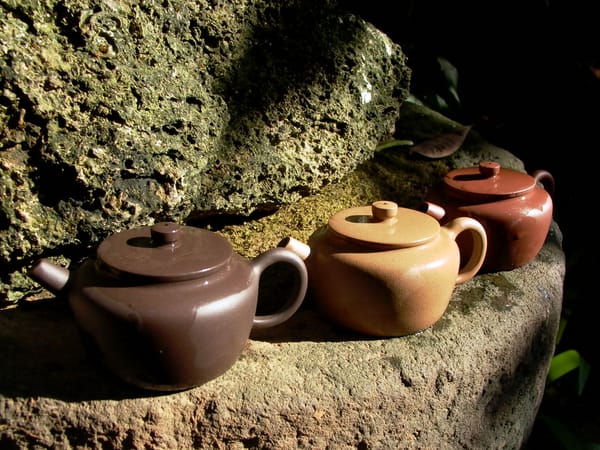It was a quiet morning. Sunlight slanted through the window as I gazed at the Yixing teapot in my hands, and my thoughts drifted back to the first time I encountered a teapot. Back then, I was simply drawn to its appearance, unaware of the depth of knowledge behind a well-made pot. Now, every time I boil water, awaken the tea, brew, and taste, I can feel the unique story carried by each teapot.
Whether you’re just getting to know teapots or already have a collection, let’s begin this journey together, starting with the most basic—yet most essential—first lesson: the shape and capacity of a teapot.
The Secret of Round and Square Teapots: A Reflection of Heaven and Earth
More Than Just Form—A Philosophy of the Cosmos
The shape of a teapot embodies traditional Chinese philosophy. Have you ever wondered why some teapots are round while others are square? This is no coincidence, but a reflection of the Chinese worldview of "round heaven and square earth." A round pot, like the sky, is full and harmonious; a square pot, like the earth, feels grounded and steady. Holding a round pot, you may sense celestial balance. A square pot, with its defined lines, gives a sense of calm and stability.
Form Affects Flavor
Each teapot shape brings out different characteristics in the tea. The aesthetics of a pot’s form also serve functional purposes. For example, the plump, rounded body of a Xishi teapot isn’t just pleasing to the eye—it allows tea to circulate well inside, making it ideal for brewing oolong tea. In contrast, a square pot, with its distinct internal angles, better suits certain black or Pu-erh teas.
Now that we’ve explored the importance of form, let’s turn to another equally vital element: the pot’s capacity and its practical value.
How Much Can It Hold? Understanding Volume Through the “Six-Cup Teapot”
Volume and the Tasting Experience
When choosing a teapot, size matters. The commonly heard phrase “six-cup zhuni pot” actually contains an implicit understanding of balance—between tea quantity, flavor intensity, and number of drinkers. You’ll often hear this in old teahouses: “This is a six-cup pot.” But what does “six cups” really mean? It’s a seemingly simple question that requires a precise grasp of volume.
Small or Large: From Solo Sipping to Social Sharing
A teapot’s volume directly impacts how the tea leaves unfurl and the strength of the brew. A small pot for solo use may hold only 100 ml, while a larger one for sharing might go up to 400 ml or more. The traditional “six cups” isn’t just about how many servings the pot produces—it reflects the nuanced relationship between pot, tea, and number of drinkers.
Matching Volume to the Tea You Brew
The right match between tea type and teapot size makes all the difference. Imagine you’re brewing a fragrant Tieguanyin—what kind of pot would you choose? A pot that’s too large could let the aroma escape too quickly; too small, and the leaves won’t fully unfurl. A well-matched pot lets the aroma bloom and the flavor stay balanced.
From practical function, we now turn to the emotional experience a teapot can offer.
Feeling the Breath of the Teapot: From Shape to Emotion
Do Teapots Have Emotion? Discovering the Teapot’s “Vitality”
A teapot’s charm lies in its expressive nature. It’s not just about form—it’s about feeling. When you look closely at a teapot, can you sense its “liveliness”? That vitality comes not only from a potter’s decades of experience, but also from the clay itself—aged, fermented, and full of potential.
The Spout, the Handle, the Details—Feeling the Pot’s Personality
Every part of a good teapot speaks of its character. From spout to handle, from lid to body—each element should flow in harmony. Does the spout pour quickly or gently? Does the handle rest comfortably in the hand? These small details convey a pot’s “personality.” Lifting the pot and pouring tea is more than a routine—it becomes a silent conversation with the pot.
Once you’ve felt this connection, you can begin to appreciate how form and spirit come together in a teapot’s artistry.
Meeting a Teapot That “Speaks”: Artistry in Form and Spirit
What Is “Form and Spirit in Harmony”? The Soul of the Teapot
True appreciation begins with form but finds meaning in spirit. One of the most important aesthetic principles in evaluating a teapot is “form and spirit in harmony.” It’s not just about accurate shape, but whether the pot conveys a sense of spirit or soul. Consider a Yixing flower-decorated teapot adorned with plum blossoms—not simply as decoration, but as the potter’s way of capturing the essence of plum branches in full bloom, subtly infusing the pot with fragrance and character.
How to Tell an Artistic Teapot from a Mass-Produced One
A great teapot moves the heart—it’s more than just an object. To those who truly appreciate teapots, it’s not just about beauty but the soul within. Mass-produced pots, made to meet market demand, may look similar in form but often lack that vital essence. They rarely evoke the same emotional response.
From artistry, we now explore the craftsmanship behind the structure of a well-made pot.
The Hidden Structure of a Teapot: The Modular System
Why Do Similar Pots Feel So Different? The Magic of Modular Design
The structure of a teapot is a carefully composed art. Have you ever noticed how two pots that look similar can feel completely different? Often, it comes down to their modular system. This refers to how the spout, lid knob, handle, and body are combined in a harmonious design.
From Ancient China to Modern Times: The Wisdom of Modular Craftsmanship
Modular design gives teapots infinite variety. As German scholar Lothar Ledderose once noted, Chinese art often utilizes modular systems—standardized parts combined to create diverse outcomes. The same applies to teapot-making: pair a tall knob with a wide lid, or a curved handle with a flatter body, and the whole feel changes.
Subtle Differences: Round vs. Flattened Duo-Qiu Pots
The artistry is in the details. Take the round and flattened versions of the Duo-Qiu (stacked sphere) pot. While their lid diameters may be the same, the knob on the round one is usually taller than that of the flattened version. These small differences are what make modular design so fascinating.
Now, let’s look at how you can begin your journey into teapot appreciation, from first glance to deep understanding.
Starting Your Teapot Journey: From Form to Soul
The Four Stages of Teapot Appreciation: A Gradual Learning Process
Appreciating teapots is a gradual journey of discovery. It takes time, patience, and a keen eye. From admiring a pot’s shape to sensing its deeper spirit, every step is part of the teapot lover’s path.
At first, you may simply be drawn to the look of a pot. Later, you begin noticing proportions, structure, and subtle details. Over time, you sense the emotions and energy it conveys. Eventually, you’ll come to understand the delicate relationship between teapot, tea, and the people who share it.
Finding the Teapot That Speaks to Your Soul
A good teapot is like a kindred spirit. Each pot has its own personality, just as each person has their own story. When you find the one that resonates with you, it’s like meeting an old friend—familiar and comforting.
Let’s finish with some practical advice on choosing your very first teapot.
How to Choose Your First Yixing Teapot
Three Key Factors for Beginners
For newcomers, the three most important factors are practicality, suitability, and feel. First, consider the type of tea you drink most often. Different teas pair best with different shapes and sizes. Next, match the size of the pot to your drinking habits—a small pot is great for solo sessions, while a larger one suits social settings. Finally, the grip should feel right—comfort leads to long-lasting enjoyment.
Basic Guidelines for Matching Teapot Shapes to Tea Types
Choosing the right shape helps your tea shine. Here are a few general recommendations:
- Xishi Pot: Great for oolong teas. Its round body allows leaves to unfurl fully.
- Shih Piao Pot: Ideal for green teas. Smooth pour and preserves fragrance.
- Jinnang Pot: Suits aged Pu-erh teas. Thick walls retain heat well.
- Jinglan Pot: Best for black teas. Wide mouth lets leaves spread and pour easily.
Common Questions from Teapot Beginners
Q1: How Should I “Open” a New Yixing Teapot?
Opening a new pot helps it perform at its best. First, rinse the pot inside and out with clean water several times. Then, soak it in boiling water a few times until the water is clear and odorless. Finally, brew the type of tea you plan to use regularly—this helps season the pot with the tea’s aroma.
Q2: How Do I Know If a Pot’s Size Is Right for Me?
The easiest way is to consider your drinking habits. If you usually drink alone, a pot of 100–200 ml is suitable. If you often share tea, go for 300–400 ml. You can also fill the pot with water and measure its capacity instead of relying solely on the seller’s description.
Q3: How Do I Care for My Teapot?
Daily care is simple. Rinse it with clean water—never use detergent. Keep it dry, but out of direct sunlight. Season it regularly with the same type of tea. If you won’t use it for a while, store it in a ventilated, dry space.
Conclusion: The Art of Dancing with a Teapot
The world of teapots is deep and enchanting. From your first encounter to a lifelong understanding, the journey is long—but delightful. By focusing on a pot’s shape and capacity, you’ve already taken the first step into this world.
Remember, appreciating a teapot isn’t just about looking—it’s about feeling. When you hold a pot, sensing its weight, texture, and warmth; when you sip the tea it brews, tasting the balance and aroma—you’ll begin to understand why the ancients said, “One teapot, one world.”
In this fast-paced world, let us slow down. Spend time with a good teapot. Brew tea. Savor the moment. Perhaps that’s the highest realm of teapot appreciation—not just seeing the beauty in the pot, but through it, discovering the beauty in life.
Let’s begin this journey together—from the humble beginnings of shape and size—toward a deeper understanding of the soul of the teapot.



